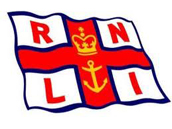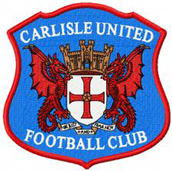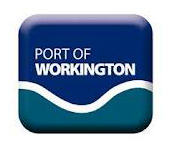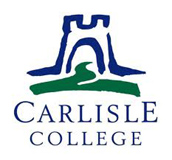- Home
- Scarrows
- Mariners
- Cumberland
- Miscellaneous
Whitehaven
History
Whitehaven was a fishing village until the 17th century. The Priory of St Bees owned the village until Henry VIII dissolved the monasteries in 1539.
In 1630 Sir Christopher Lowther purchased the estate. He decided to use Whitehaven as a port for exporting coal from the Cumbrian coalfield. In 1634 he built a stone pier where ships could load and unload cargoes. He then began to export coal to Ireland. In 1630 Whitehaven had a population of around 250 and by the standards of the time it was a large village.
Whitehaven soon began to grow. The original settlement was around the market place. Chapel Street and King Street were built in the 1640s. Roper Street was also built around that time. It was given its name because ropers made rope there. At the end of the 17th century rope making moved to Brackenthwaite.
In 1660 the lord of the manor gained the right to hold a market and a fair in Whitehaven. A fair was like a market but was held only once a year for a few days. Buyers and sellers would come from all over Cumbria to attend the Whitehaven fair.
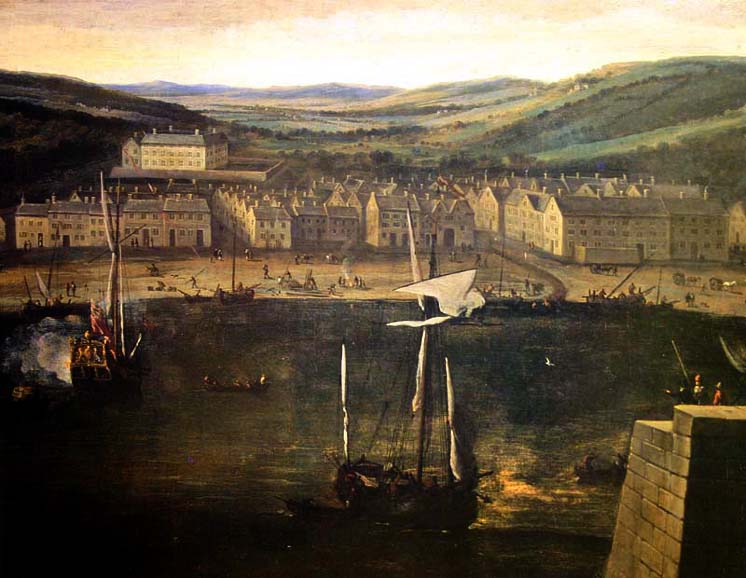
Whitehaven 1686
The port of Whitehaven grew rapidly. Until 1685 it was officially part of the port of Carlisle but in that year it was made independent by which time it had a population of over 1,000. It continued to grow rapidly and by 1700 the population was around 3,000. By the standards of the time Whitehaven was a fair sized town and it continued to grow.
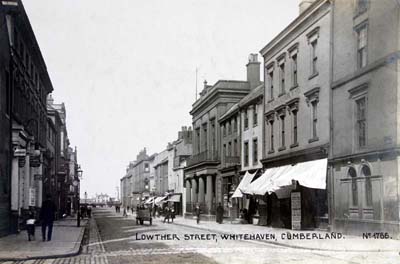 Whitehaven was laid out in a grid pattern. Church Street was built in the 1660s, with Queen Street, Lowther Street (pictured), Strand Street, New Street, Duke Street, James Street and College Street being built in the 1680s.
In 1693 the Church of St Nicholas was built in Whitehaven to replace an existing chapel. The fleet of ships based in the port of Whitehaven (which included the coast from the Ellen to the Duddon) also grew. In 1676 there were 32 ships, by 1685 there were 46 and in 1689 there were 55. From the 1670s tobacco from Virginia was imported and by the 1740s only London imported more tobacco than Whitehaven. Large quantities of rum and sugar were also imported into Whitehaven. Whitehaven's main export was still coal.
Whitehaven was laid out in a grid pattern. Church Street was built in the 1660s, with Queen Street, Lowther Street (pictured), Strand Street, New Street, Duke Street, James Street and College Street being built in the 1680s.
In 1693 the Church of St Nicholas was built in Whitehaven to replace an existing chapel. The fleet of ships based in the port of Whitehaven (which included the coast from the Ellen to the Duddon) also grew. In 1676 there were 32 ships, by 1685 there were 46 and in 1689 there were 55. From the 1670s tobacco from Virginia was imported and by the 1740s only London imported more tobacco than Whitehaven. Large quantities of rum and sugar were also imported into Whitehaven. Whitehaven's main export was still coal.
In the 1720s Daniel Defoe wrote that Whitehaven had grown up from a small place to be a very significant one as a result of the coal trade which has increased so considerably of late. It is now the most eminent port in England for shipping of coal except Newcastle and Sunderland.
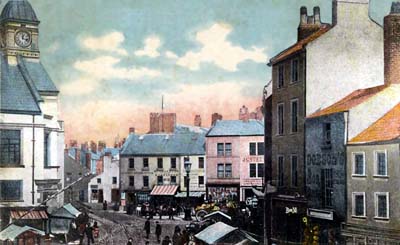 Whitehaven continued to grow rapidly. St James's Church in Queen Street was built in 1753 and Whitehaven castle was built in 1769. In 1762 a survey showed Whitehaven had a population of 9,063 which made it a large and important town, and around this time several new streets were built including Charles Street, Scotch Street, Catherine Street, George Street and New Town. From 1781 the streets of Whitehaven were lit with oil lamps. In 1783 a dispensary was opened were the poor could obtain free medicines.
Whitehaven continued to grow rapidly. St James's Church in Queen Street was built in 1753 and Whitehaven castle was built in 1769. In 1762 a survey showed Whitehaven had a population of 9,063 which made it a large and important town, and around this time several new streets were built including Charles Street, Scotch Street, Catherine Street, George Street and New Town. From 1781 the streets of Whitehaven were lit with oil lamps. In 1783 a dispensary was opened were the poor could obtain free medicines.
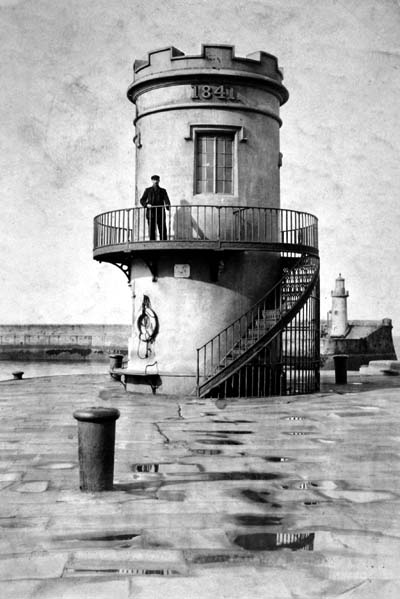 The port was greatly enlarged, with the building of Sugar Tongue quay in 1735 (for unloading sugar from the West Indies and Lime Quay (for the export of lime) in 1754. In the town the port related industries of shipbuilding rope making and sail making folourished. Meanwhile coal mining boomed in the Whitehaven area. Ever increasing quantities were exported from Whitehaven and by the late 18th century Whitehaven was the 6th largest port in England with a fleet of 448 ships. The photo on the left shows Whitehaven Lighthouse, built in 1841.
The port was greatly enlarged, with the building of Sugar Tongue quay in 1735 (for unloading sugar from the West Indies and Lime Quay (for the export of lime) in 1754. In the town the port related industries of shipbuilding rope making and sail making folourished. Meanwhile coal mining boomed in the Whitehaven area. Ever increasing quantities were exported from Whitehaven and by the late 18th century Whitehaven was the 6th largest port in England with a fleet of 448 ships. The photo on the left shows Whitehaven Lighthouse, built in 1841.
However in the late 18th century the merchants of Glasgow took away much of the tobacco trade from Whitehaven, and later the American War of Independence finally ended the trade altogether.
In 1778 (during the American war of Independence) a ship captained by John Paul Jones attacked the port of Whitehaven in which 3 ships were destroyed in the harbour. Jones was born in Scotland but apprenticed as a seamen in Whitehaven.
In 1806 the streets of Whitehaven were paved, and in 1830 the oil powered street lights were replaced by gas lighting, to be altered again in 1893 to be lit by electricity. A railway line was built to Whitehaven in 1847. In 1852 Whitehaven had a piped water supply, augmented by a sewarage system in the 1860s. The first public library in Whitehaven opened in 1888.
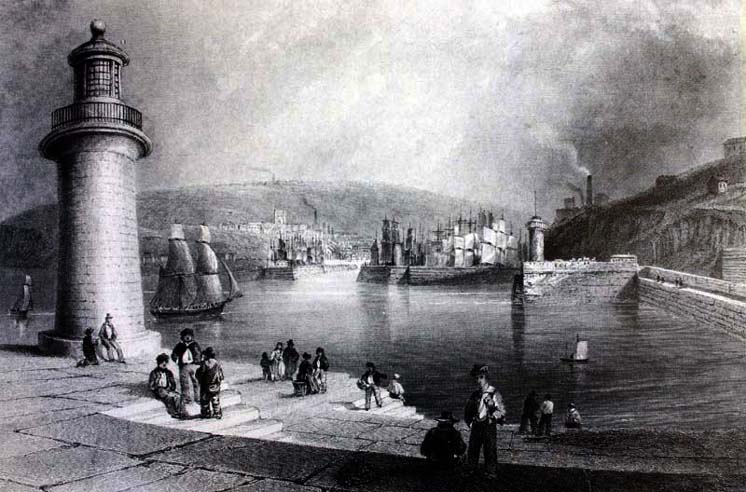
Whitehaven Harbour 1840
In the 19th century coal mining in the Whitehaven area continued to boom, but towards the end of the 19th century shipbuilding declined. In the 19th century there was a pottery industry in Whitehaven but it closed at the time of the First World War. The port of Whitehaven continued to prosper largely because of exports of coal, with West Pier being built in 1838, North pier in 1841 and the Queens Dock in 1876.
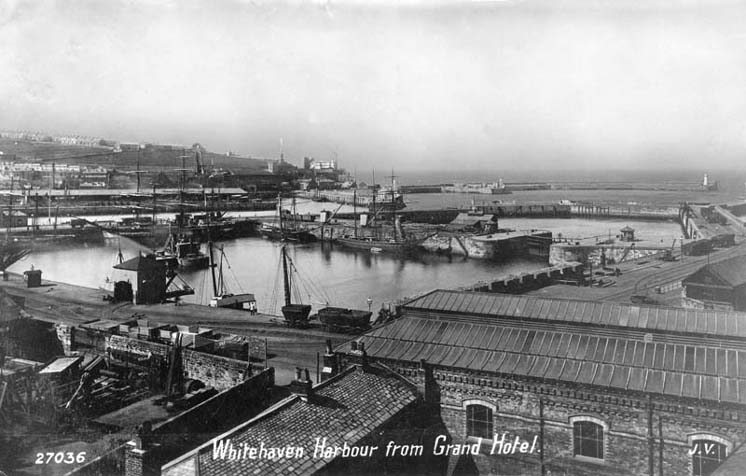
Whitehaven Harbour 1900
By 1901 Whitehaven had a population of about 19,000. In the 1920s and 1930s Whitehaven council built its first council houses, with many being built after World War II. Whitehaven castle was converted into a hospital in 1926, and then replaced by the West Cumberland hospital which was completed in 1964. In the 20th century industries in Whitehaven included silk manufacture and chemicals and the port continued to be busy. However, coal mining in the area finally ended in the 1980s.
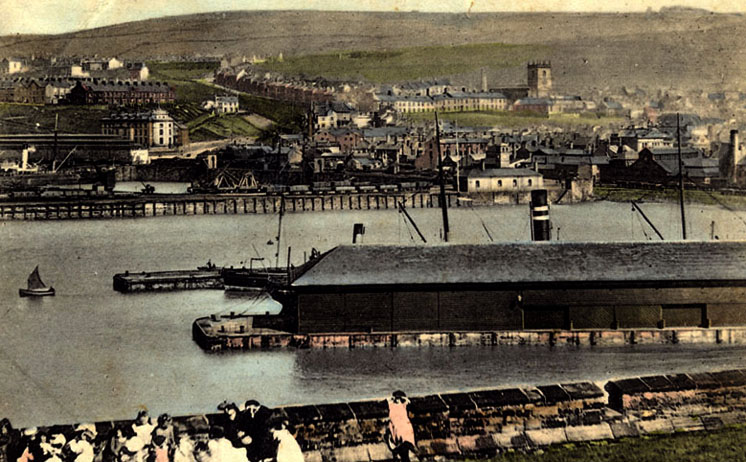
Whitehaven Harbour looking North, circa 1900
At the end of the 20th century Whitehaven underwent a renaissance. In 1993 a company was formed to refurbish the harbour and parts of the town. Old buildings on Sugar Tongue were demolished. A 40-metre tower called the Crows Nest with a viewing platform was built. In 1998 a sea lock was built enclosing the harbour together with a 100-berth marina. The whole harbour was lighted. On Lime Tongue a light sculpture called The Wave was built. This sculpture is reflected in the sea and is green on one side of the tongue and blue on the other.
The Beacon opened in 1996 and the first maritime festival was held in 1999. Haig colliery (which had closed in 1986) was converted into a museum in 1997. Another museum called Rum Story was built in 2000. Today Whitehaven has a population of 25,500.
Imports
| Goods | Place of Origin |
|---|---|
| Sugar | West Indies |
| Rum | West Indies |
| Timber | Baltic, Canada |
| Tobacco | Virginia, USA |
Exports
| Goods | Destination |
|---|---|
| Coal | Britain, Ireland |
| Lime | Britain, Ireland |
Industry
| Port Industries | Other Industries |
|---|---|
| Shipbuilding | Coal Mining (until 1980) |
| Sail-making | Pottery Works (until 1945) |
| Ropery | Chemical Works (20th Century) |
| Silk Manufacture (20th Century) |
Scarrow Associations
Along with Harrington, Workington, Liverpool and London; Whitehaven was one of the (five) ports in which one or more of the Scarrow mariners was based. Some of the sailing ships in which the Scarrow's sailed were registered here.
| Scarrow | Period |
|---|---|
| John Scarrow I | 1763-1769 |
| John Scarrow II | 1826-1829 |
| Joseph Scarrow | 1831-34, 1838, 1843, 1846, 1850, 1854-55 |
| William Scarrow | 1835-38, 1846, 1850, 1856 |

